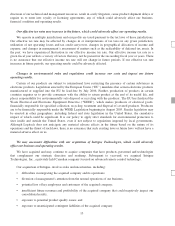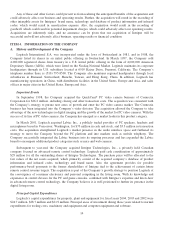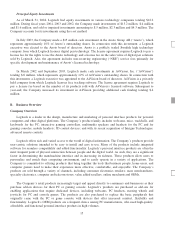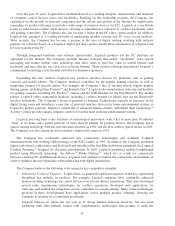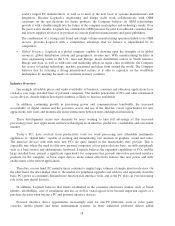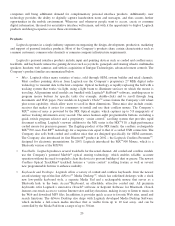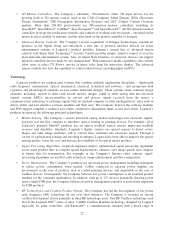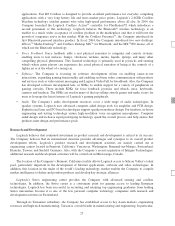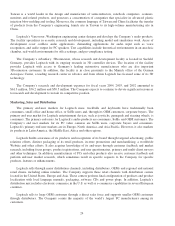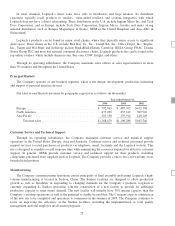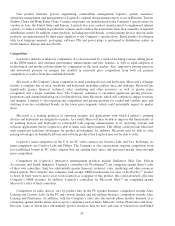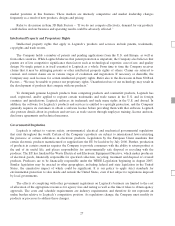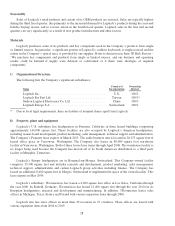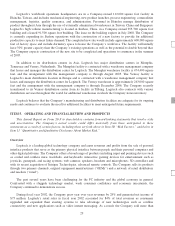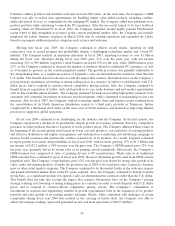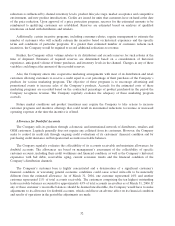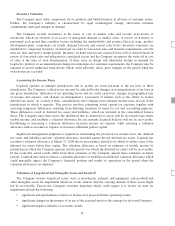Logitech 2004 Annual Report Download - page 61
Download and view the complete annual report
Please find page 61 of the 2004 Logitech annual report below. You can navigate through the pages in the report by either clicking on the pages listed below, or by using the keyword search tool below to find specific information within the annual report.
applications. Fast RF Cordless is designed to provide excellent performance for everyday computing
applications with a very long battery life and mass market price points. Logitech’s 2.4GHz Cordless
Freedom technology satisfies gamers who value high-speed performance above all else. In 2004, the
Company launched the Logitech Cordless Action™controller for PlayStation®2 which introduces a
second generation of this technology. Logitech believes the Bluetooth®wireless technology is an
enabler to a much wider acceptance of cordless products in the marketplace and that it will boost the
growth of companies active in this market. With the Cordless Presenter™, the Company introduced its
first Bluetooth personal interface product. In fiscal 2004, the Company introduced two new desktops,
diNovo™Media Desktop™and Cordless Desktop MX™for Bluetooth, and the MX™900 mouse, all of
which use the Bluetooth technology.
•Force Feedback. Force feedback adds a real physical sensation to computer and console systems,
enabling users to feel surfaces, bumps, vibrations, textures, inertia, liquids, springs, and many other
compelling physical phenomena. This licensed technology is primarily used in joysticks and steering
wheels where game players can experience the actual physical sensation of being at the controls of a
fighter jet or at the wheel of a racing car.
•Software. The Company is focusing its software development efforts on enabling easier-to-use
interactions, expanding gaming functionality and enabling real-time video communication with products
and services such as video instant messaging and Logitech VideoCall for broadband. Also, the Company
has developed software development kits, or SDKs, to enable support for a variety of peripherals on
gaming consoles. These include SDKs for force feedback joysticks and wheels, mice, keyboards,
cameras and headsets. The SDKs are used in many of the top selling console games and make it easy for
users to leverage the latest features of Logitech’s gaming peripherals.
•Audio. The Company’s audio development resources cover a wide range of audio technologies. In
speaker systems, Logitech uses advanced computer aided design tools for amplifier and PCB design.
Sophisticated laser and PC-based technologies support speaker transducer design. For headsets, in-house
engineering and testing technology ensure high-resolution voice recognition microphones. Computer
aided design and in-house rapid prototyping technology speed the overall process and help ensure that
products meet design and performance goals.
Research and Development
Logitech believes that continued investment in product research and development is critical to its success.
The Company believes that its international structure provides advantages and synergies to its overall product
development efforts. Logitech’s product research and development activities are mainly carried out at
engineering centers located in Fremont, California; Vancouver, Washington; Romanel-sur-Morges, Switzerland;
Hsinchu, Taiwan; and Seefeld, Germany. Also, with the Company’s recent acquisition of Intrigue Technologies,
additional research and development activities will be carried out in Mississauga, Canada.
The location of the Company’s Fremont, California facility allows Logitech access to Silicon Valley’s talent
pool, particularly important in the development of Internet applications, software and video technologies. In
addition, this location in the midst of the world’s leading technology market enables the Company to compile
market intelligence to define and position products and develop key strategic alliances.
Logitech’s Swiss engineering center provides the Company with advanced sensing and cordless
technologies. In addition, the Swiss center is a convenient point for gaining access to leading European
technologies. Logitech has been successful in recruiting and retaining top engineering graduates from leading
Swiss universities because it is one of the few personal computer technology companies with research and
development activities in Switzerland.
Through its Taiwanese subsidiary, the Company has established access to key Asian markets, engineering
resources and high-tech manufacturing. Taiwan is a world leader in manufacturing and engineering. In particular,
23


